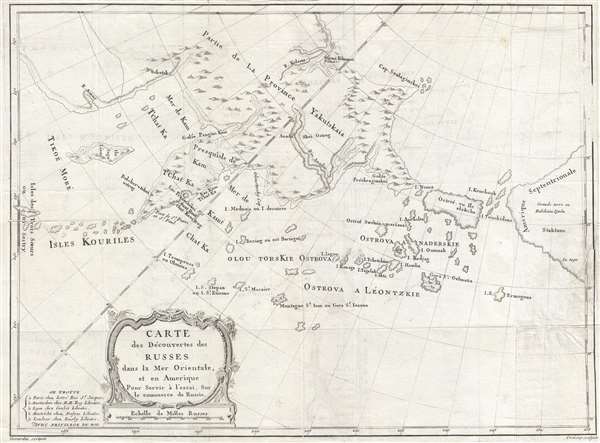This item has been sold, but you can get on the Waitlist to be notified if another example becomes available, or purchase a digital scan.
1777 Croisey Map of the Russian Discoveries in Alaska and Bering Strait
AlaskaSiberia-croisey-1777
Title
1777 (undated) 16 x 21.75 in (40.64 x 55.245 cm) 1 : 10000000
Description
The result was a series of confused maps of the Aleutian Islands and the American coast based on a combination of unscientific Promyshlenniki mapping and flawed interpretations of Inuit cartographic knowledge. The most important of these was the secret expedition of Ivan Synd, whose cartography though now lost, caused Gerhard Muller to redraw his important map of 1758. The second state of Muller's map, issued in 1773, replaces his iconic peninsula with a series of islands – as reported by Synd, including the island of 'Alakcha' - marking some of the earliest usage of that term, which was an Aleut term meaning 'big island' or possibly 'mainland.'
Although the map here clearly owes some debt to Muller's second map, particularly in the treatment of the American mainland and the shape of the islands of 'Alakcha,' it is far from a slavish copy and the nomenclature employed suggests the author had access to additional Russian source material. The proto-Aleutian Islands south of 'Alakcha' island appear unrelated in form, nomenclature, and situation, to any previous known work, including that of Muller and may reference lost Synd cartography, Andrean Tolktykh's expedition, the explorations Petr Krenitsyn and Mikhail Levashev, or possibly even other lesser known Promyshlenniki literature. Certainly, much of the nomenclature is derived directly from Krenitsyn and Levashev, and given the secretive nature of this voyage, it is remarkable that their nomenclature found its way into Marbault's work.
This map was published to illustrate Marbault's, Essai sur le Commerce de Russie, avec l'Histoire de ses Decouvertes, issued in Amsterdam in 1777. The work is one of the earliest works on Russian commerce. Marbault's sources are something of a mystery, but he was in Russia at while preparing his work serving as secretary to M. Durand, then minister of France in Russia, and thus may have had direct access to Russian geographical sources and traders. This map was engraved by P. Croisey. The text was engraved by Gerardin.
Cartographer
P. Croisey (fl. c. 1765 – c. 1800) was a French line-engraver active in the 18th century. Croisey was based in Versailles, France and is best known for his fine portrait of Marie Antoinette, when Dauphiness. He also maintained a location on Rue Haute-Feuille, Pairs. One of his early trade cards survives in which he describes himself as a geographical engineer and engraver of civil and military architecture, topography, and geography. His wife, Madame Croisey was also an engraver, specializing in music and text. He died around 1800. More by this mapmaker...

